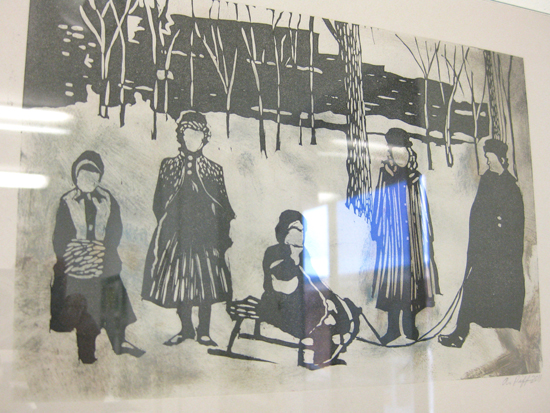For the final Combined Print Media class students drew inspiration from the
City of Portland's historic collection of records and documents. In November we trekked downtown to visit the Archives and Records center, where we got a chance to see some of the stacks and view some interesting historical pieces of ephemera from the city's extensive collection. City Archivist Diana Banning and Assistant City Archivists Brian Johnson and Mary Hansen gave us a wonderful tour and talk that introduced the class to the archives' holdings and their use.
The objective of the final project was to use the archives to research a topic of interest, and from there create a printed piece inspired by that research. Some of the students were inspired to make work which directly referred to their research, and others created work a bit removed from the original source, but in every case there is a germ of the original material evident.
Below are some snapshots of the results!
:::::::::::::
S. Swan became inspired looking into early street formation in downtown Portland. Early Portland city designers were interested in creating a walkable, 'human-scale' city, and the transformation occurred relatively fast. In a matter of years, Portland went from having a jumble of streets filled with tree stumps and potholes full of mud, to an organized and logically laid out grid.
Swan's work reflects her own experience walking in Portland, and captures the feeling of momentary glimpses and dislocated bits of information.
Untitled
Linocut, silkscren, photopolymer plates.
R. Bryant responded to a clipping from a Communist newsletter accusing the Portland police of setting up and instigating a crime in order to frame them. The Portland police claimed just the opposite, and well, fingers were pointed.
Bryant took the idea of finger pointing and the human desire to place the blame on the opposite party and rendered it in black and white. She made use of OCAC's ornament collection and found as many fingers and arrows as possible. It's interesting to think about how usually these ornaments are used to direct someone's attention to important information, yet in this case they simply reflect each other endlessly.
R. Bryant
Untitled
Letterpress printed ornaments, wood type, and sorts
M. Latham was inspired by photos from the Fire Bureau, and wanted to take on the challenge of rendering fire in print. Latham's humor is also evident in the title of this piece, which pokes at restaurant and 'foodie' culture always trying to outdo itself.
Latham did render this print four ways, blending techniques in a way that she wanted to hone from earlier assignments. It's difficult to tell in some places where one techniques ends and another begins.
M. Latham
Restaurant Fire, Four Ways
Acrylic drypoint, photopolymer plate, linocut, monoprinting
A. Piff was also inspired by a number of photographs from the collection. Portland used to employ a city photographer whose job it was to document development, construction, repairs, and catastrophes around the city. The photographer also captured minor events and slices of every day life of ordinary citizens.
Piff was particularly interested in those captured moments where, had they not been photographed, might have easily been forgotten Their documentation has leant them an air of importance in history. She was also interested in images that speak to what was important at the time they were taken, and how what we deem as important and document-worthy has changed over the years.
Untitled
Linocuts and hand-painting
E. Derge found an indignant letter to the editor that scolded the City of Portland for allowing a circus sideshow act to go on that included a lewd performance: belly-dancing! This inspired Derge to look into circus acts and their sideshows, which in turn led her to research medical oddities and developmental abnormalities. Fetus in Fetu is such an abnormality. I'm going to let readers do their own research on this one!
E. Derge
Fetus in Fetu
Letterpress printed using photopolymer plates, hand die-cutting, intaglio relief rolled plates, hand-built box.
B. Chavez found a historical scrapbook commemorating the flood of 1894. Her inspiration came not only from the object itself and the fact that such a scrapbook would have been made for such an event, but that it also contained a very poetic introduction.
Chavez reinterpreted the introduction, writing some of her own lines of poetry, and also interpreted the photography contained within the scrapbook by creating acrylic drypoints and binding them in between the slips words. The result is an elegant object responding to tragedy.
B. Chavez
A City Underwater
Handset type letterpress printed, acrylic intaglio, hand-bound book.
B. Sullivan initially researched the Benson Bubblers, and the man behind them, Simon Benson.
What you see here is not his response to that research...
...
B. Sullivan
Untitled
Silkscreen and inkjet printing.
R. Kapka found some official paperwork documenting animal acquisition at the zoo. Her response was amusement at the bureaucratic language and format of these documents, when we are so accustomed to the public face of the zoo and the more personal language we typically use when referring to animals. Her inspiration developed into an exploration of break-downs in communication, and exploring the areas where data intersects with the personal. Her piece forces the meeting of bureaucracy and absurdity, where the quotidian meets the bizarre.
R. Kapka
Untitled
Letterpress printed, handset type, photopolymer plate, hand-bound, foil-stamping










































